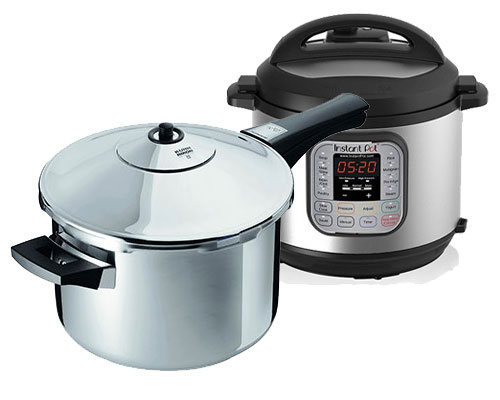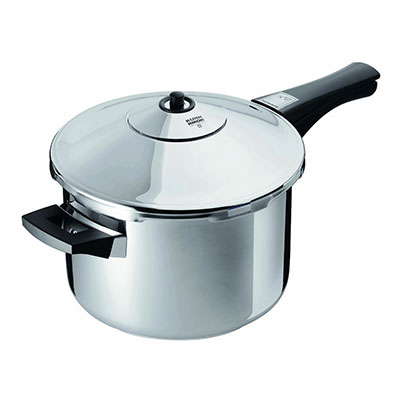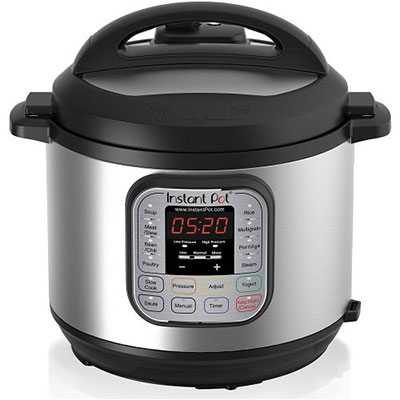
The Stove Top Pressure Cooker vs Electric Pressure Cooker Debate Still Rages On. Each Side Can Point to the Many Advantages of Both. Let’s Take a Quick Look.
Advantages of Stove-Top Pressure Cookers
Let’s start with stove-top pressure cookers. It’s hard to contest that stove-top pressure cookers can offer the best value for the money with regard to their quality and the length of their service. They are quicker to heat up to pressure and temperature, and are much quicker to release their pressure than the electric ones.

The time it takes to bring a stove-top cooker up to temperature and pressure is shorter than a digital cooker by as much as a few minutes. This is done by starting out with your burner or heating element turned up high. When the maximum pressure/temperature is achieved, you must then reduce the heat to a lower setting to maintain the pressure/temperature.
When the food is finished cooking, the stove-top version is considerably quicker to release the pressure. You may wish to relieve the pressure in your dish because as long as your food is still under pressure, it is continuing to cook, even after you’ve turned the heat off. The residual heat within the pot will continue to cook the food.
This may not be a concern if you’re preparing meats that you want very tender, but prolonging the cook-time, may turn items like vegetables or rice to mush. So for certain meals, you would want to stop the cooking cycle at a specific cook-time by relieving the pressure, along with the heat. You can do this by first removing the pot from the heated burner to a cool surface, and then carefully opening the release valve. Just follow your cookers instructions.
With electric cookers, the heating elements and insulated pot need time to cool, which prolongs the time to release the built-up pressure and temperature.
With stove-top cookers, there are no power cords and no electronics to burn out, which does happen, so they aren’t susceptible to breakdowns as the electric ones are. Stove-tops are great for multitasking. They usually have a larger standard capacity than electrics, and lend themselves to cooking large roasts and whole chickens.
If you plan on canning, you should purchase a stove-top model that’s intended for that purpose. A pressure cooker is not as sophisticated as a canner. Cookers do not usually have built-in temperature gauges and cannot maintain the temperature accuracy needed to destroy the harmful bacteria that causes botulism. Some pressure canners will lend themselves to pressure cooking, but it really depends on what you want to cook.
The bottom line is, cookers are made for cooking, and canners are made for canning.
Note: Electric models are NOT recommended for pressure canning.
You can find stove-top pressure cookers in sizes ranging from 6 to 8-quarts, and much larger. The larger ones are intended for pressure canning but can also be used for preparing delicious dinners, as with any other pressure cooker. Virtually all electric pots are only available in 4 or 6-quart sizes. While this is enough to serve from 2-4 people, it’s not as easy to cook larger batches as you may sometimes want.
Modern stove top cookers adhere to a 13-15 PSI (90-103 kPa) industry standard, allowing the cookers to maximize the cooking temperature and shortening the time it takes to complete the cook-time.
In contrast, the maximum operating pressures in electric cookers vary greatly between manufacturers. Many, or most electric models are not capable of achieving the high pressure of stove-top models and need more time to achieve the same results.
If an electric pressure cooker can not reach the 13-15 PSI standard, you’ll need to adjust the cook-time from what is recommended in most cookbooks.
All pressure cookers require a certain amount of cooking fluid, generally water, some of which turns to pressurized steam, which distributes the heat throughout the cooker and food.
Electric cookers tend to need more liquid than stove-top versions. Electric cookers have been known to be oversensitive and have shut off automatically if they sense too little cooking liquids in the pot, whereas stove-tops are more forgiving.
The base of stove-top pressure cookers can be used as normal open-top cooking pots, where as most electrics cannot.
Stove-top pressure cookers can be used on gas-stoves, electric-stoves, induction elements, ceramic and glass cook-tops.
Everyone agrees that although they’re more expensive over the aluminum ones, the better pots are made of stainless steel. Aluminum pots will leach aluminum molecules into your food which tends to give it a unwanted metallic taste. Furthermore, many scientific reports have detailed the serious health effects that aluminum poisoning can have on the body.
Advantages of Electric Pressure Cookers
Perhaps the greatest advantage of the electric pressure cooker is that once the electric cooker is programmed and started, you can just walk away from it and it’ll complete the cooking and depressurizing automatically.
Conversely, the stove-top cookers need close monitoring from start to finish.

Those who like their electric pressure cookers, love their electric cookers. The electric pressure cooker has really come of age recently. Today’s modern electric cookers are greatly improved and have eliminated many of the issues from just a couple of years ago.
Much of the complexity in programming have been simplified. On many brands, the inner cooking pots have become more durable and are easier to handle than previous models.
While the insulation and enclosed heating element of the electric cookers makes it take longer to release the pressure at the end of the cook cycle, it’s these very attributes that make electric pressure cookers extremely energy efficient appliances, holding the heat in rather than dissipating it into the kitchen. This can make a huge difference in your comfort level while cooking during warm weather.
The efficiency of electric pressure cookers may be better or comparable to a stove-top versions, but both are significantly more efficient than non-pressurized, open-top cooking.
An electric cooker is completely automated. You only need to select the desired pressure or program, set the cook-time, then hit “start”.
Conclusion
One thing that everyone agrees on is that whichever type of cooker you decide to go with, make sure that the cooking pot is made of stainless steel, not aluminum, and not coated with teflon, which is toxic. A teflon coating will deteriorate and eventually erode into your food, so it’s best to avoid pots made with those materials.
I hope this article has helped to give you enough information to decide whether a stove top pressure cooker vs electric pressure is right for you. Each will save you time and energy.
Both types will greatly shorten the time it takes to prepare meals. They will hold in and enhance wonderful flavors within your foods and help maintain healthful vitamins and enzymes.
With only very little experience with either type, you’ll create delicious masterpieces that will impress. So your decision may come down to your personal preferences. Some people use both.
Good luck to you and happy cooking. Thanks for reading!
Check out the Top-Rated Electric Pressure Cookers available at Amazon.

Why cant I seal the lid back on after cooking meat. I want to add vegetables, which take a shorter cooking time.